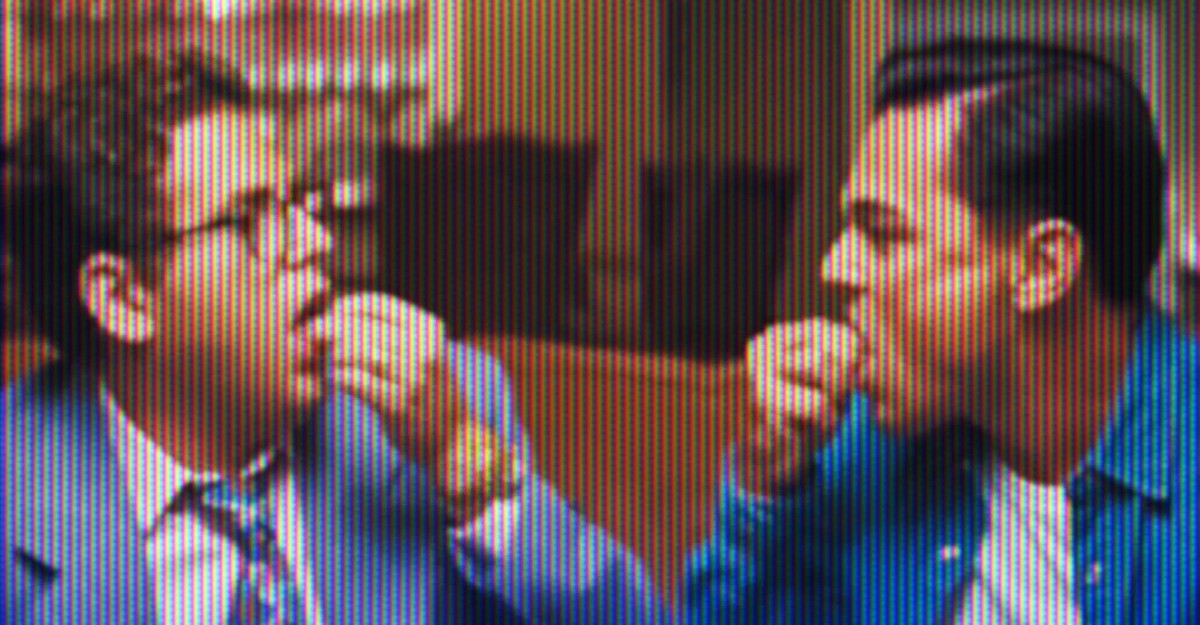There are two ways of taking pills—two and only two.
You pinch the pill between your thumb and index finger, pick it up, and place it on your tongue. You take a drink of water. This method is the tweezers.
Or else: You place the pill in your palm and launch it toward your mouth, as if your teeth were battlements and your arm a siege machine. Don’t bother with the water. This method is the catapult.
In real-world situations, many people—let’s say most—make a habit of the tweezers. In the movies, the opposite is true. An on-screen pill bottle works like Chekhov’s gun: Eventually, its contents will be fired at an actor’s mouth, or smashed between his lips, or hurled into his gullet.
Think of Austin Butler as the lead in Elvis, alone in his hotel room: He slaps those quaaludes in, liquid-free, sideburns tilted toward the ceiling. It’s a textbook movie swallow, the Stanislavski Fling. Butler got an Oscar nomination; so did Ellen Burstyn, popping diet pills in Requiem for a Dream. On Succession, Jeremy Strong and Kieran Culkin, each a two-time Emmy nominee, gobble meds on-screen. Going catapult is everywhere in cinema; it’s a gesture that befits the biggest stars. Angelina Jolie shoots her pills in Girl, Interrupted. So does Brittany Murphy. Jake Gyllenhaal catapults a pill in Donnie Darko. Albert Brooks in Modern Romance. In Goodfellas, Ray Liotta does it twice.
I love the movies! But it’s time we had a public-health announcement: The catapult is not, in fact, how a person should be taking pills. The act of swallowing a medication is so pervasive—and so intimate—that one easily forgets it is a skill that must be learned. In the U.S., roughly three-fifths of all adults are on prescription drugs; perhaps one-sixth will falter when they try to gulp it down. Twenty years ago, Bonnie Kaplan, a research psychologist at the University of Calgary, devised a new technique for helping people overcome this problem. Her method, as laid out in a mesmerizing video, suggests that you turn your head to make a pill go in. (No one has ever done this in a movie and no one ever will.) The turning motion helps open your upper esophageal sphincter, Kaplan says, though she does admit that more familiar postures have their own advantages. Some people like to raise their chins: “They say it is easier for the pill to slide down their throat, as if their tongue is a ski jump and it is a straight shot down the hill.” Others tip their heads the other way, chin-to-chest, “because they say it is more relaxing in the neck.”
But on the all-important matter of the hand, Kaplan’s messaging is very clear: You pick up the pill between your fingers; then you place it on your tongue. Which is to say, you do the tweezers. Other training methods are consistent with this rule. One approach for teaching children, published in 1984, describes “correctly placing” a pill on the back of the tongue—which clearly cannot be accomplished via a whole-hand toss; another, from 2006, says to “place the pill on your tongue towards the back of your mouth.”
That’s how people ought to take their pills. But how do people really do it, in real life? At the start of her research, Kaplan told me, she wasn’t telling takers what to do; she spent time observing how they liked to swallow medications on their own. The cinematic catapult was simply nonexistent in the wild, she said. “I never saw anyone just throw it back.” Never? Anyone? I asked Kaplan to describe the way she swallows pills herself, and she paused before she answered, as if she’d never really thought this through. “My husband and I both turn our heads to the right,” she said at last. First she’ll place the pill on the back of her tongue, and then she’ll twist and swallow. “But you know what?” she said. “I do often clap my hand to my mouth with my last pill or two.”
“It’s very individual,” Cindy Corbett, a nursing-science professor at the University of South Carolina, told me. She’s on a team that uses smartwatch accelerometers to track patients’ adherence to their medication regimen. Their system knows when someone moves a hand up to their face, she told me, but it won’t distinguish how a pill is being held, or whether it is placed or flung into the mouth. (Indeed, the study’s four-step “protocol-guided medication-taking activity” includes this ambivalent instruction: “Place/toss pill to mouth.”) When I asked Corbett what she’s seen herself in this regard, as a clinician, she drew a blank. “I’ve never thought about it that much.”
Maybe this is it: If you even have to think about the way you swallow pills, then you’re almost certainly someone who has trouble taking pills; and if you’re someone who has trouble taking pills, then you really should be taking pills in tweezer mode. In the off-screen world, to catapult is a privilege reserved for those with floppy throats. It’s the difference between the gags and the gag-nots. That inequality is only reinforced by the movieland fantasy of universal tossing, which sets up (as only Hollywood knows how) an impossible and unhealthy standard for behavior. Look, Elvis gobbles benzos; why can’t I? “People’s preconceived notions of how they’re supposed to swallow pills does lead to mental barriers,” says Marissa Harkness, a co-creator of the Pill Skills training kit, a case of sugar-based placebos made in different shapes and sizes.
When actors catapult on camera, they get the benefit of looking more dramatic: bigger gestures, more to see. But something more important is going on in movie swallows, a deeper meaning to the movement—an implied relationship of power. Taking pills by catapult suggests that you’re a victim, that your body and your mind are under siege. A hand that’s driven by compulsion fires drugs into the face. A teenage boy is pelted by his Prozac. But some stories need to have this flipped, so the pill can be a tool instead of an affliction. In Taxi Driver, Robert De Niro tweezers bennies. He’s a man on a mission. And the most famous pill-taking scene in movie history, from The Matrix, has Keanu Reeves pinch a pill between his thumb and index fingers in dramatic close-up, and deposit it into his mouth. Then he drinks a glass of water. (Is that a movie first?) A character who tweezers is going on a journey, the film director John Magary told me. He’s curious. He’s in control. (From Magary’s films to date: two catapults, zero tweezers.)
Perhaps the movies have this figured out. There are two ways of taking pills—two and only two. The tweezers or the catapult; self-knowledge or oblivion. In the end, the choice is yours.






